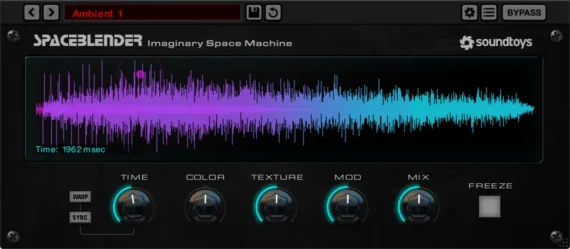Soundtoys Releases SpaceBlender ‘Experimental Reverb’ And It’s Free Through May 22
Pro audio effects creator Soundtoys today announced the release of SpaceBlender, an experimental reverb that they say lets you create unreal and imaginary spaces, with shapes, textures, and tones that would be impossible in the real world.
Described as an “imaginary space machine”, SpaceBlender is an experimental reverb that brings together a unique and innovative approach, inspired by the tape looping techniques used by pioneering ambient musicians, with a nod to vintage digital reverbs such as the Lexicon 224, Ursa Major Space Station and Eventide DSP4000.
Whether enhancing a track’s sense of space or creating dynamic, evolving effects, SpaceBlender is a fun and intuitive tool for sound designers, musicians, and producers looking for creative yet easy-to-use spatial processing.
Unlike many reverb plugins, SpaceBlender isn’t based on feedback delay networks or convolution, but a newly-developed algorithm inspired by swarm synthesis. As such, Soundtoys says the plugin is far more than “just another reverb”: it’s a sound design tool that lets you “create imaginary spaces and effects that don’t exist in the real world”.
Despite its unconventional approach, SpaceBlender has a simple and intuitive interface, centred around an interactive visualiser. Displaying incoming signals in purple and reverb in blue, the visualizer lets you shape the reverb’s envelope by dragging a cursor across the display: the X axis controls the envelope shape, while the Y axis adjusts the amount of envelope shaping applied.
The dial below the visualizer adjusts reverb time, which can stretch from 100ms to an entire minute and sync to your DAW’s tempo. Here you’ll also find a Warp button, which modulates the pitch and speed of the reverb and introduces classic tape echo-style smoothing when the Time control is tweaked.

The Color knob controls how the tonal balance of the reverb changes over time; turning it clockwise makes the sound grow brighter as the signal passes through the reverb, and vice versa. The Texture dial adjusts reverb density, much like a diffusion control, and the Mod control adjusts the depth of SpaceBlender’s lush, chorus-like modulation effect (the shape and rate are set at fixed values).
You’ll also find a Freeze button that captures and loops the current sound – ripe for ambient experimentation – and a Mix knob that does what you’d expect it to. SpaceBlender arrives with a healthy selection of presets, and the interface is resizable, something many Soundtoys fans have been requesting for a while.
SpaceBlender is unique, inventive and – despite being relatively light on controls – hugely versatile: it can do expansive ambient spaces, snappy gated reverbs and fun reverse effects, while also handling more conventional applications. It also sounds phenomenal – check out the preset demo video below:
Features:
- Interactive control – move between gate, reverse, decay, and bloom reverb shapes and everything in-between, in real time.
- Visualizer – see your sound move through the reverb shape as you adjust its sonic envelope.
- Simple control of spectral evolution; reverbs can get darker or brighter over time.
- Deeply embedded modulation creates rich, constantly moving ambient effects.
- Smoothly change the reverb texture from dense and lush to sparse and grainy.
- Extreme range from super short 100-millisecond nonlinear effects to absurdly long 60-second meditations.
Soundtoys’ SpaceBlender is available now for free – a $99 value – through May 22 at this link. SpaceBlender will be available for purchase from authorized resellers worldwide for $99 US beginning May 23.
Learn about Soundtoys’ system requirements and host compatibility here.

























